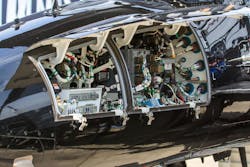From CAD to Co-Design: Mastering AI, Material Science, Digital Twins and MBSE
Key Highlights:
- AI-powered design tools are now fundamental, enabling faster iterations, optimized configurations and system-level insights.
- Mastering simulation platforms and digital twins allows for virtual prototyping, real-time system optimization and reduced physical testing.
- Proficiency in model-based systems engineering (MBSE) enhances project management, compliance and cross-disciplinary collaboration.
Enjoying Machine Design’s Industrial Equipment & Heavy Machinery content? Be sure to check out the rest of our Takeover Week coverage here.
You may have noticed that the field of engineering is undergoing a revolution. As motion control, heavy mobile machinery and other equipment becomes more autonomous, electric and AI-driven, design complexity increases. In turn, powerful tools have emerged for engineers.
Among them are the expanding range of AI enhancements and add-ins for CAD/CAE, simulators that use real and synthetic data and digital twinning platforms. The use of model-based systems engineering (MBSE) is also now growing rapidly, providing a supportive digital framework to manage projects, enhance collaboration and ensure compliance.
As we navigate this new era, it’s useful to ask ourselves how the fundamentals of engineering are evolving. How are the historic core fundamentals of engineering changing? What are the new fundamentals that are now here to stay, just as AI is here to stay?
All the new fundamentals of engineering may not yet be clear, but we do know that with those we can pin down so far, engineers must gain proficiency—even mastery—in using them in order to manage the increasing design complexity of autonomous and electrified machines.
Engineers must also be proficient in these new fundamentals, says Craig Resnick, VP, consulting at global industry research and consulting firm ARC Advisory Group, “to accelerate development cycles and reduce costly rework, as well as to ensure safety, regulatory compliance and traceability.” In addition, proficiency is needed “to collaborate effectively across disciplines and lifecycle stages, and to drive innovation confidently using virtual tools and data-driven insights.”
New Fundamental: Proficiency in Using AI as a Co-Designer
AI platforms that automate both design exploration and design optimization are here to stay. To become proficient in their use, today’s engineers are learning to set focused parameters to guide the AI in generating design options that met project requirements. This includes parameters for the optimal operation of the part (or the motion system or entire machine), not just a part’s shape, size and what it’s made of.
Of course, AI is enabling engineers do a myriad of other things, such as looking at many different orientations and configurations of how components are placed within a space, enabling efficient comparisons and conclusions about trade-offs in a minimal amount of time.
As Théophile Allard, chief technology officer at Neural Concept, explains, “since the 1990s, design and engineering have evolved into being digital-first, thanks to CAD and CAE. AI adds a new layer, with new abstractions and interfaces that extend the traditional digitalization stack with more agility.
“These AI-powered tools provide real-time physics evaluations and help manage system-level complexity,” he adds. “As pressure is growing for industries to accelerate development speed—because of the increasingly competitive landscape—the groundbreaking agility brought by AI is rapidly establishing these tools as new fundamentals.”
Indeed, in Allard’s view, AI is setting a new bar in the design cycles of complex physical products such as industrial machines, cars and planes. “It acts as a fast copilot within CAD and CAE environments, automating repetitive tasks, suggesting design changes and delivering instant performance feedback,” he says. “This sets new development standards toward faster iterations, more informed trade-offs and earlier integration of system-level and multidisciplinary insights.”
New Fundamental: Proficiency in Using Simulation and Digital Twins
The ability to master the use of simulation platforms and digital twinning enables engineers to efficiently complete many new and revolutionary design-related tasks, says Resnick. These include virtual prototyping, lifecycle performance prediction and bridging physical and digital systems for real-time optimization.
As Allard reports, “AI can now power complex, system-level digital twins with real-time physical behavior simulation. They also bridge the gap between MBSE and detailed 3D design with high-fidelity physics. AI copilots on 3D design interact directly with system models, enabling early detection of trade-offs across components and disciplines. This elevates detailed physical evaluations from component design feedback to actual system decision-making tools.”
READ MORE: High-Performance Plastics for Friction and Wear Applications
Recently, using the NC platform, MIT’s DrivAerNet++ dataset for vehicle design was transformed using the Neural Concept platform. A whopping 39TB of aerodynamic simulation data were turned into a production-ready AI model within days, which Allard says is proof that digital twins can now be trained and deployed quickly at an industrial scale. This means shorter design cycles, lower costs and faster, more-confident decision-making at every stage of vehicle development for automotive OEMs.
New Fundamental: Proficiency with MSBE
The fundamentals of MSBE, in Resnick’s view, include managing complexity across software domains, which in turn enable traceability, compliance, collaborative design and integrating multi-domain collaboration.
“Interdisciplinary integration combines mechanical, electrical and software design into unified workflows, which is essential for electrified and autonomous systems,” he says. “Digital thread and data management connects product lifecycle data to supports configuration control, collaboration, continuous improvement and auditability.”
New Fundamental: Fluency in Polymer Engineering
A good working knowledge of polymer technology is a new fundamental of engineering. Industry experts are estimating that within five years, the use of polymers in various motion control components will be 10 times what it is today.
To gain maximum efficiencies and protect company profitability, it is imperative mechanical engineers keep up-to-date with advances in thermoplastic composites and an understanding of the custom compounds that can now be created with very specific attributes (read more about technical characteristics of cutting-edge plastics in our recent Members-only Machine Design article here).
Polymer is now being used in bearings, valve components, structural components (including thin-walled parts), smaller gears (and now making inroads in larger gears) and much more. New plastics are being released each month, and the customization capabilities of plastics manufacturers are growing steadily as well.
Historic Fundamentals: Evolution
As to how much true historic fundamentals of engineering are evolving in an era of AI-based tools, sensors and new materials, Resnick says that while design iteration is still grounded in classical engineering logic, it’s now faster and more data-driven. “Physics and engineering science are now being applied through simulation and AI tools,” he explains. “Systems engineering has shifted from document-based to model-based. Testing and prototyping are increasingly virtual, with simulation replacing many physical tests.”
READ MORE: The Digital Evolution of Heavy Machinery: Understanding Model-Based Systems Engineering
At the same time, in his view, certain engineering fundamentals will always apply, including manufacturing and quality fundamentals such as tolerancing and validation, along with safety and reliability principles such as fail-safe and redundancy.
“Core physics and math fundamentals, such as statics, dynamics [and] thermodynamics always apply,” he adds. “Also, engineering judgment, creativity and critical thinking, along with ethics and professional responsibility, remain core.”
For his part, Allard first explains that traditionally, the building of complex machines followed rigid, step-by-step processes, such as the V-cycle in the automotive sector. Specialized teams focused on separate components and disciplines, he notes, which required constant alignments and trade-offs. At the same time, information flow across stakeholders was a major bottleneck.
“AI copilots are now reshaping the architecture of engineering processes, collapsing the traditional V-cycle by bridging gaps between system-level and detailed design, and between early concepts and late-stage validation,” he explains. “This shift empowers engineers to work in tighter, cross-functional loops, running thousands of simulations daily and sharing insights across disciplines.”
Allard explains that as a result of all this, engineering roles are evolving: “We now need AI-literate engineers who understand physics and product development processes. Their mission is to encode domain expertise into AI tools shared with others. This powers the rise of what we call quantitative design: data-driven, physics-aware designers working in smaller, agile teams, with a deeper ownership of full systems, who run thousands—if not hundreds of thousands—of iterations per day and continuously share multidisciplinary insights.”
But Allard also notes that one fundamental of engineering, internal know-how, will never disappear or diminish in value.
“Each engineering team, specialized in building systems for specific applications, has accumulated unique expertise, linking design practices, manufacturing methods and customer needs,” he asserts. “This remains their core competitive advantage. What’s changing is how that know-how is captured and scaled. Encoding expertise into AI workflows amplifies its impact, strengthens resilience to shifting requirements and team turnover and transforms domain knowledge into a shared, strategic asset.”
Cautions on the Road Ahead
Allard notes that the investments of industrial companies and OEMs in AI for product development are already large and the momentum is strong, but at the same time, many firms are focusing too narrowly on individual technical capabilities. True success in his view requires a strategy driven by outcomes and supported by a holistic approach to evolving IT architecture.
“In CAD/CAE, IT traditionally meant HPC [high-performance computing],” Allard explains. “Today, AI-enhanced workflows demand both HPC and elastic, scalable cloud infrastructure. Physics-aware models increasingly operate alongside large language models, enabling agentic workflows that combine physics, 3D modeling, domain-specific context and design decision-making.”
READ MORE: MBSE Gains Ground in Heavy Equipment Industry
The key to success, says Allard, is integration. The best approach is to bring these technologies into a single, unified IT environment—modular, secure and embedded into engineering workflows.
“This integration supports not only technical performance but also agility and resilience across teams and systems,” he says. “The architecture must be elastic and modular, while guaranteeing the maximum levels of security and sovereignty. This flexibility at the level of IT architecture mirrors and supports the agility at the level of the new processes, ensuring teams get the very best out of AI.”
About the Author

Treena Hein
Treena Hein is an award-winning science and technology writer with over 20 years’ experience.


